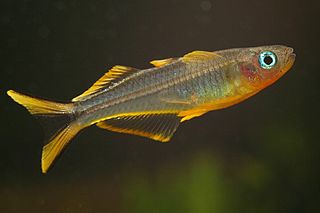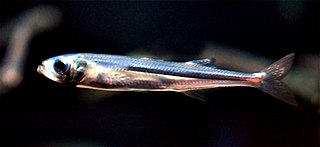
The Atheriniformes, also known as the silversides, are an order of ray-finned fishes that includes the Old World silversides and several less-familiar families, including the unusual Phallostethidae. The order includes at least 354 species. They are found worldwide in tropical and temperate marine and freshwater environments.

The rainbowfish or Melanotaeniidae is a family of small, colourful freshwater fish found in northern and eastern Australia, New Guinea, Sulawesi and Madagascar.
The Old World silversides are a family, Atherinidae, of fish in the order Atheriniformes. Atherinidae are abundant and considered bony fish (teleost) that are widespread globally, living in rivers, estuaries, and coastal waters. They occur worldwide in tropical and temperate waters. About two-thirds of the species are marine, and the remainder live in fresh water. The 74 species are in 13 genera. The genus Craterocephalus is the most diverse with 25 species. Four genera are monotypic.
Mercer's tusked silverside is a species of fish.

Craterocephalus is a genus of small and slender brackish or freshwater silversides from Australia and New Guinea. It is the most diverse genus in the family Atherinidae, containing 25 of the 71 species.
Craterocephalus lentiginosus, the freckled hardyhead is a species of fish in the family Atherinidae endemic to the Kimberley region in the northwest of Australia. It is also called the Prince Regent hardyhead.
The Pima hardyhead is a species of silverside in the family Atherinidae which is endemic to Papua New Guinea. This species was described in 1991 by Walter Ivantsoff, Lucy Crowley and Gerald R. Allen with the type locality given as the junction of Pima and Tua rivers. It has not been recorded since the collection of the types.

Pseudomugil is a genus of fish in the subfamily Pseudomugilinae endemic to Australia and New Guinea, where they are found in freshwater rivers and streams and bodies of brackish water.

The Pseudomugilidae, the blue-eyes, are a subfamily of atheriniform fish in the rainbowfish family Melanotaeniidae. They inhabit fresh and brackish water in Australia, New Guinea and nearby smaller islands. Blue-eyes are small fish, typically no more than 5 cm (2.0 in) in length. Like the larger Melanotaeniid rainbowfish, they spawn all year round, and attach their eggs to vegetation.
Kestratherina is a genus of silversides endemic to the eastern Indian Ocean off southern Australia.
Atherion is a small genus of silversides, known as the pricklenose silversides. It is the only genus in the family Atherionidae. Other authorities classify this as a monogeneric subfamily, Atherioninae, of the Atherinidae, while others include it within the subfamily Atherinomorinae. They have an Indo-Pacific distribution.
Bleheratherina pierucciae is a species of freshwater silverside endemic to New Caledonia. This species grows to 4.7 cm (1.9 in) in standard length. It is the only known species in its genus and subfamily. This species was described by Aarn and Walter Ivantsoff in 2009 with the type locality of the Tontouta River, New Caledonia,. The type was collected by Heiko Bleher and Paola Pierucci and Aarn and Ivantsoff named this species after both of them, the suffix -ae indicating Ms Pierucci's gender.
Leptatherina is a genus of silversides, one freshwater and one marine, native to Australia.
Iso is an Indo-Pacific genus of silversides, commonly called surf sardines, the only genus in the monogeneric family Isonidae, they were formerly classified in the family Notocheiridae alongside the surf silverside but they are now thought to be within the suborder Atherinoidei while the surf silverside is classified in the suborder Atherinopsoidei, along with the Neotropical silversides. It contains five species to date, the first of which was described in 1895.

Ovalentaria is a clade of ray-finned fishes within the Percomorpha, referred to as a subseries. It is made up of a group of fish families which are referred to in Fishes of the World's fifth edition as incertae sedis, as well as the orders Mugiliformes, Cichliformes, and Blenniiformes. It was named by W. L. Smith and T. J. Near in Wainwright et al. (2012) based on a molecular phylogeny, but the authors suggested that the group was united by the presence of demersal eggs that are attached to a substrate. Some authors have used the ordinal name Stiassnyiformes for a clade including Mugiloidei, Plesiopidae, Blenniiformes, Atherinomorpha, and Cichlidae, and this grouping does appear to be monophyletic.

Atherinopsinae is a subfamily of the Neotropical silversides, part of the family Atherinopsidae. This subfamily is made up of two tribes, six genera and around 30 species. They are found in the eastern Pacific and south-western Atlantic and the subfamily contains marine, brackish and freshwater species.

Atherinoidei is a suborder of the order Atheriniformes comprising six families, with a mainly Old World distribution, although a few species are found in the western Atlantic Ocean.
The pricklenose silverside is a species of silverside from the family Atherionidae. It is found in the western Indian Ocean from India to KwaZulu Natal in South Africa. It is a prey species for many commercially caught larger fish and may be used as bait by fishermen, usually caught at depths of less than 2 metres (6.6 ft). This species was described in 1965 by James Leonard Brierley Smith from a type locality of Inhaca Island, Mozambique. It is distinguished from similar species of silverside within its range by the rough, shagreen-like skin around its snout.

Atherinomorinae is a subfamily of silversides from the family, Atherinidae, the Old World silversides.

Craterocephalinae is a subfamily of silversides from the family, Atherinidae, the Old World silversides. The majority of the species in this subfamily are freshwater fish, although some occur in brackish water. They are found in Australia and New Guinea.








